Appraisal of SMAP Operational Soil Moisture Product from a Global Perspective
Abstract
:1. Introduction
2. Materials and Methods
2.1. In Situ Measurements
2.2. Satellite Data Description
2.2.1. SMAP L4 Soil Moisture Product
2.2.2. NASA Global Precipitation Measurement Integrated Multi-SatellitE Retrievals for GPM (IMERG)
2.3. Performance Statistics
3. Results
3.1. North America
3.1.1. Performance Comparison at Different Stations
3.1.2. Temporal Consistency
3.2. Europe
3.2.1. Performance Comparison at Different Stations
3.2.2. Temporal Consistency
3.3. Asia
3.3.1. Performance Comparison at Different Stations
3.3.2. Temporal consistency
3.4. Australia
3.4.1. Performance comparison at different stations
3.4.2. Temporal Consistency
4. Discussion
5. Conclusions
Author Contributions
Funding
Acknowledgments
Conflicts of Interest
References
- Piles, M.; Petropoulos, G.P.; Sánchez, N.; González-Zamora, Á.; Ireland, G. Towards improved spatio-temporal resolution soil moisture retrievals from the synergy of SMOS and MSG SEVIRI spaceborne observations. Remote Sens. Environ. 2016, 180, 403–417. [Google Scholar] [CrossRef] [Green Version]
- Carlson, T.N.; Petropoulos, G.P. A new method for estimating of evapotranspiration and surface soil moisture from Optical and Thermal Infrared measurements: The simplified triangle. Int. J. Remote Sens. 2019, 40, 7716–7729. [Google Scholar] [CrossRef]
- Srivastava, P.K.; Han, D.; Ramirez, M.R.; Islam, T. Appraisal of SMOS soil moisture at a catchment scale in a temperate maritime climate. J. Hydrol. 2013, 498, 292–304. [Google Scholar] [CrossRef]
- Njoku, E.G.; Entekhabi, D. Passive microwave remote sensing of soil moisture. J. Hydrol. 1996, 184, 101–129. [Google Scholar] [CrossRef]
- Srivastava, P.K.; Han, D.; Rico-Ramirez, M.A.; O’Neill, P.; Islam, T.; Gupta, M.; Dai, Q. Performance evaluation of WRF-NOAH Land Surface Model estimated soil moisture for hydrological application: Synergistic evaluation using SMOS retrieved soil moisture. J. Hydrol. 2015, 529, 200–212. [Google Scholar] [CrossRef]
- Engman, E.T.; Chauhan, N. Status of microwave soil moisture measurements with remote sensing. Remote Sens. Environ. 1995, 51, 189–198. [Google Scholar] [CrossRef]
- Srivastava, P.; O’Neill, P.; Cosh, M.; Kurum, M.; Lang, R.; Joseph, A. Evaluation of dielectric mixing models for passive microwave soil moisture retrieval using data from comrad ground-based SMAP simulator. IEEE J. Sel. Top. Appl. Earth Obs. Remote Sens. 2014, 8, 4345–4354. [Google Scholar] [CrossRef]
- Choi, M.; Hur, Y. A microwave-Optical/Infrared disaggregation for improving spatial representation of soil moisture using AMSR-E and MODIS products. Remote Sens. Environ. 2012, 124, 259–269. [Google Scholar] [CrossRef]
- Srivastava, P.K.; Yaduvanshi, A.; Singh, S.K.; Islam, T.; Gupta, M. Support vector machines and generalized linear models for quantifying soil dehydrogenase activity in agro-forestry system of mid altitude Central Himalaya. Environ. Earth Sci. 2016, 75, 299. [Google Scholar] [CrossRef]
- Deng, K.A.K.; Lamine, S.; Pavlides, A.; Petropoulos, G.P.; Bao, Y.; Srivastava, P.K.; Guan, Y. Large scale operational soil moisture mapping from passive MW radiometry: SMOS product evaluation in Europe & USA. Int. J. Appl. Earth Obs. Geoinf. 2019, 80, 206–217. [Google Scholar]
- Tian, X.; Xie, Z.; Dai, A.; Shi, C.; Jia, B.; Chen, F.; Yang, K. A dual-pass variational data assimilation framework for estimating soil moisture profiles from AMSR-E microwave brightness temperature. J. Geophys. Res. Atmos. 2009, 114, 1–12. [Google Scholar] [CrossRef] [Green Version]
- Fuzzo, D.F.S.; Carlson, T.N.; Kourgialas, N.N.; Petropoulos, G.P. Coupling remote sensing with a water balance model for soybean yield predictions over large areas. Earth Sci. Inform. 2019, 13, 345–359. [Google Scholar] [CrossRef]
- Bao, Y.; Lin, L.; Wu, S.; Deng, K.A.K.; Petropoulos, G.P. Surface soil moisture retrievals over partially vegetated areas from the synergy of Sentinel-1 and Landsat 8 data using a modified Water-Cloud model. Int. J. Appl. Earth Obs. Geoinf. 2018, 72, 76–85. [Google Scholar] [CrossRef]
- Laymon, C.A.; Manu, A.; Crosson, W.L.; Jackson, T.J. Defining the range of uncertainty associated with remotely sensed soil moisture estimates with microwave radiometers. In Remote Sensing for Earth Science, Ocean, and Sea Ice Applications; SPIE Digital Library: Bellingham, DC, USA, 1999; pp. 504–513. [Google Scholar]
- Gupta, M.; Srivastava, P.K.; Islam, T.; Ishak, A.M.B. Evaluation of TRMM rainfall for soil moisture prediction in a subtropical climate. Environ. Earth Sci. 2013. [Google Scholar] [CrossRef]
- Srivastava, P.K.; Han, D.; Rico-Ramirez, M.A.; O’Neill, P.; Islam, T.; Gupta, M. Assessment of SMOS soil moisture retrieval parameters using tau–omega algorithms for soil moisture deficit estimation. J. Hydrol. 2014, 519, 574–587. [Google Scholar] [CrossRef] [Green Version]
- Srivastava, P.K.; Han, D.; Rico-Ramirez, M.A.; Al-Shrafany, D.; Islam, T. Data fusion techniques for improving soil moisture deficit using SMOS satellite and WRF-NOAH Land Surface Model. Water Resour. Manag. 2013, 27, 5069–5087. [Google Scholar] [CrossRef]
- Wagner, W.; Hahn, S.; Kidd, R.; Melzer, T.; Bartalis, Z.; Hasenauer, S.; Figa-Saldaña, J.; de Rosnay, P.; Jann, A.; Schneider, S. The ASCAT soil moisture product: A review of its specifications, validation results, and emerging applications. Meteorol. Z. 2013, 22, 5–33. [Google Scholar] [CrossRef] [Green Version]
- Njoku, E.G.; Jackson, T.J.; Lakshmi, V.; Chan, T.K.; Nghiem, S.V. Soil moisture retrieval from AMSR-E. IEEE Trans. Geosci. Remote Sens. 2003, 41, 215–229. [Google Scholar] [CrossRef]
- Imaoka, K.; Maeda, T.; Kachi, M.; Kasahara, M.; Ito, N.; Nakagawa, K. Earth Observing Missions and Sensors: Development, Implementation, and Characterization II. In Status of AMSR2 Instrument on GCOM-W1; SPIE Digital Library: Bellingham, DC, USA, 2012; p. 852815. [Google Scholar]
- Kerr, Y.H.; Waldteufel, P.; Wigneron, J.-P.; Delwart, S.; Cabot, F.; Boutin, J.; Escorihuela, M.-J.; Font, J.; Reul, N.; Gruhier, C. The SMOS mission: New tool for monitoring key elements ofthe global water cycle. Proc. IEEE 2010, 98, 666–687. [Google Scholar] [CrossRef] [Green Version]
- Entekhabi, D.; Njoku, E.G.; O’Neill, P.E.; Kellogg, K.H.; Crow, W.T.; Edelstein, W.N.; Entin, J.K.; Goodman, S.D.; Jackson, T.J.; Johnson, J. The Soil Moisture Active Passive (SMAP) mission. Proc. IEEE 2010, 98, 704–716. [Google Scholar] [CrossRef]
- Srivastava, P.K.; Petropoulos, G.; Kerr, Y.H. Satellite Soil Moisture Retrieval: Techniques and Applications; Elsevier: Amsterdam, The Netherlands, 2016; ISBN 9780128033883. [Google Scholar]
- Srivastava, P.K. Satellite soil moisture: Review of theory and applications in water resources. Water Resour. Manag. 2017, 31, 3161–3176. [Google Scholar] [CrossRef]
- Tebbs, E.; Wilson, H.; Mulligan, M.; Chan, K.; Gupta, M.; Maurya, V.; Srivastava, P. Satellite soil moisture observations: Applications in the UK and India. In Report of Pump Priming Project the India-UK Water Centre; Wallingford and Pune: Dehradun, India, 2019. [Google Scholar]
- Srivastava, P.K.; Pandey, P.C.; Petropoulos, G.P.; Kourgialas, N.N.; Pandey, V.; Singh, U. GIS and remote sensing aided information for soil moisture estimation: A comparative study of interpolation techniques. Resources 2019, 8, 70. [Google Scholar] [CrossRef] [Green Version]
- Srivastava, P.K.; Pandey, P.C.; Kumar, P.; Raghubanshi, A.S.; Han, D. Geospatial Technology for Water Resource Applications; CRC Press: Boca Raton, FL, USA; Taylor and Francis: Abingdon, UK, 2016; ISBN 9781498719681. [Google Scholar]
- Srivastava, P.K.; Han, D.; Ramirez, M.R.; Islam, T. Machine learning techniques for downscaling SMOS satellite soil moisture using MODIS Land Surface Temperature for hydrological application. Water Resour. Manag. 2013, 27, 3127–3144. [Google Scholar] [CrossRef]
- Deng, K.A.K.; Lamine, S.; Pavlides, A.; Petropoulos, G.P.; Srivastava, P.K.; Bao, Y.; Hristopulos, D.; Anagnostopoulos, V. Operational soil moisture from ASCAT in support of water resources management. Remote Sens. 2019, 11, 579. [Google Scholar] [CrossRef] [Green Version]
- Dobriyal, P.; Qureshi, A.; Badola, R.; Hussain, S.A. A review of the methods available for estimating soil moisture and its implications for water resource management. J. Hydrol. 2012, 458, 110–117. [Google Scholar] [CrossRef]
- Petropoulos, G.P.; Ireland, G.; Srivastava, P.K.; Ioannou-Katidis, P. An appraisal of the accuracy of operational soil moisture estimates from SMOS MIRAS using validated in situ observations acquired in a mediterranean environment. Int. J. Remote Sens. 2014, 35, 5239–5250. [Google Scholar] [CrossRef]
- Petropoulos, G.P.; Ireland, G.; Srivastava, P.K. Evaluation of the soil moisture operational estimates from SMOS in Europe: Results over diverse ecosystems. IEEE Sens. J. 2015, 15, 5243–5251. [Google Scholar] [CrossRef]
- Petropoulos, G.P.; McCalmont, J.P. An operational in situ soil moisture & soil temperature monitoring network for West Wales, UK: The WSMN network. Sensors 2017, 17, 1481. [Google Scholar]
- Petropoulos, G.; Srivastava, P.K.; Ferentinos, K.P.; Hristopoulos, D. Evaluating the capabilities of Optical/TIR imaging sensing systems for quantifying soil water content. Geocarto Int. 2018, 35, 494–511. [Google Scholar] [CrossRef]
- Dorigo, W.; Wagner, W.; Hohensinn, R.; Hahn, S.; Paulik, C.; Xaver, A.; Gruber, A.; Drusch, M.; Mecklenburg, S.; Oevelen, P.V. The International Soil Moisture Network: A data hosting facility for global in situ soil moisture measurements. Hydrol. Earth Syst. Sci. 2011, 15, 1675–1698. [Google Scholar] [CrossRef] [Green Version]
- Diamond, H.J.; Karl, T.R.; Palecki, M.A.; Baker, C.B.; Bell, J.E.; Leeper, R.D.; Easterling, D.R.; Lawrimore, J.H.; Meyers, T.P.; Helfert, M.R. US Climate Reference Network after one decade of operations: Status and assessment. Bull. Am. Meteorol. Soc. 2013, 94, 485–498. [Google Scholar] [CrossRef]
- Stancalie, G.; Catana, S.; Irimescu, A.; Savin, E.; Diamandi, A.; Hofnar, A.; Oancea, S. Contribution of earth observation data supplied by the new satellite sensors to flood management. In Transboundary Floods: Reducing Risks Through Flood Management; Springer: Berlin/Heidelberg, Germany, 2006; pp. 287–304. [Google Scholar]
- Moe, K.H.; Dwolatzky, B.; Olst, R. Designing a Usable Mobile Application for Field Data Collection. In Proceedings of the 2004 IEEE Africon. 7th Africon Conference in Africa (IEEE Cat. No. 04CH37590), Gaborone, Botswana, 15–17 September 2004; pp. 1187–1192. [Google Scholar]
- Kirchengast, G.; Kabas, T.; Leuprecht, A.; Bichler, C.; Truhetz, H. Wegenernet: A pioneering high-resolution network for monitoring weather and climate. Bull. Am. Meteorol. Soc. 2014, 95, 227–242. [Google Scholar] [CrossRef]
- Smith, A.B.; Walker, J.P.; Western, A.W.; Young, R.; Ellett, K.; Pipunic, R.; Grayson, R.; Siriwardena, L.; Chiew, F.H.; Richter, H. The Murrumbidgee soil moisture monitoring network data set. Water Resour. Res. 2012, 7, 1–6. [Google Scholar] [CrossRef]
- Cosh, M.H.; Ochsner, T.E.; McKee, L.; Dong, J.; Basara, J.B.; Evett, S.R.; Hatch, C.E.; Small, E.E.; Steele-Dunne, S.C.; Zreda, M. The Soil Moisture Active Passive Marena, Oklahoma, in situ sensor testbed (SMAP-MOISST): Testbed design and evaluation of in situ sensors. Vadose Zone J. 2016, 15, 1–11. [Google Scholar] [CrossRef] [Green Version]
- Chen, F.; Crow, W.T.; Colliander, A.; Cosh, M.H.; Jackson, T.J.; Bindlish, R.; Reichle, R.H.; Chan, S.K.; Bosch, D.D.; Starks, P.J. Application of triple collocation in ground-based validation of Soil Moisture Active/Passive (SMAP) level 2 data products. IEEE J. Sel. Topics Appl. Earth Obs. Remote Sens. 2016, 10, 489–502. [Google Scholar] [CrossRef]
- Wu, C.-C.; Margulis, S.A. Real-time soil moisture and salinity profile estimation using assimilation of embedded sensor datastreams. Vadose Zone J. 2013, 12, 1–17. [Google Scholar] [CrossRef]
- Colliander, A.; Cosh, M.H.; Misra, S.; Jackson, T.J.; Crow, W.T.; Chan, S.; Bindlish, R.; Chae, C.; Collins, C.H.; Yueh, S.H. Validation and scaling of soil moisture in a semi-arid environment: SMAP validation experiment 2015 (SMAPVEX15). Remote Sens. Environ. 2017, 196, 101–112. [Google Scholar] [CrossRef]
- Entekhabi, D.; Yueh, S.; O’Neill, P.E.; Kellogg, K.H.; Allen, A.; Bindlish, R.; Brown, M.; Chan, S.; Colliander, A.; Crow, W.T. SMAP Handbook–Soil Moisture Active Passive: Mapping Soil Moisture and Freeze/Thaw from Space; JPL Publication: Pasadena, CA, USA, 2014. [Google Scholar]
- Entekhabi, D.; Yueh, S.; De Lannoy, G. SMAP Handbook; JPL Publication: Pasadena, CA, USA, 2014. [Google Scholar]
- Chaubell, M.J.; Yueh, S.H.; Dunbar, R.S.; Colliander, A.; Chen, F.; Chan, S.K.; Entekhabi, D.; Bindlish, R.; O’Neill, P.E.; Asanuma, J. Improved SMAP dual-channel algorithm for the retrieval of soil moisture. IEEE Trans. Geosci. Remote Sens. 2020, 58, 3894–3905. [Google Scholar] [CrossRef]
- Huffman, G.J.; Bolvin, D.T.; Braithwaite, D.; Hsu, K.; Joyce, R.; Xie, P.; Yoo, S.-H. NASA Global Precipitation Measurement (GPM) Integrated Multi-Satellite Retrievals for GPM (IMERG). Algorithm Theor. Basis Doc. (ATBD) Version 2015, 4, 26. [Google Scholar]
- Huffman, G.J.; Bolvin, D.T.; Nelkin, E.J. Day 1 IMERG Final Run Release Notes; NASA/GSFC: Greenbelt, MD, USA, 2015. [Google Scholar]
- Willmott, C.J. On the validation of models. Phys. Geogr. 1981, 2, 184–194. [Google Scholar] [CrossRef]
- Willmott, C.J. Some comments on the evaluation of model performance. Bull. Am. Meteorol. Soc. 1982, 63, 1309–1313. [Google Scholar] [CrossRef] [Green Version]
- Legates, D.R.; McCabe, G.J., Jr. Evaluating the use of “goodness-of-fit” measures in hydrologic and hydroclimatic model validation. Water Resour. Res. 1999, 35, 233–241. [Google Scholar] [CrossRef]
- Chan, S.K.; Bindlish, R.; O’Neill, P.E.; Njoku, E.; Jackson, T.; Colliander, A.; Chen, F.; Burgin, M.; Dunbar, S.; Piepmeier, J. Assessment of the SMAP passive soil moisture product. IEEE Trans. Geosci. Remote Sens. 2016, 54, 4994–5007. [Google Scholar] [CrossRef]
- Renzullo, L.J.; Van Dijk, A.; Perraud, J.-M.; Collins, D.; Henderson, B.; Jin, H.; Smith, A.; McJannet, D. Continental satellite soil moisture data assimilation improves root-zone moisture analysis for water resources assessment. J. Hydrol. 2014, 519, 2747–2762. [Google Scholar] [CrossRef]
- Bindlish, R.; Jackson, T.; Cosh, M.; Zhao, T.; O’Neill, P. Global soil moisture from the Aquarius/SAC-D satellite: Description and initial assessment. IEEE Geosci. Remote Sens. Lett. 2015, 12, 923–927. [Google Scholar] [CrossRef]
- Zhang, C.; Cheng, Q.; Yang, J.; Zhao, J.; Cui, T.J. Broadband metamaterial for optical transparency and microwave absorption. Appl. Phys. Lett. 2017, 110, 143511. [Google Scholar] [CrossRef]
- Colliander, A.; Jackson, T.J.; Bindlish, R.; Chan, S.; Das, N.; Kim, S.; Cosh, M.; Dunbar, R.; Dang, L.; Pashaian, L. Validation of SMAP surface soil moisture products with core validation sites. Remote Sens. Environ. 2017, 191, 215–231. [Google Scholar] [CrossRef]
- El Hajj, M.; Baghdadi, N.; Zribi, M.; Rodríguez-Fernández, N.; Wigneron, J.P.; Al-Yaari, A.; Al Bitar, A.; Albergel, C.; Calvet, J.-C. Evaluation of SMOS, SMAP, ASCAT and Sentinel-1 soil moisture products at sites in southwestern France. Remote Sens. 2018, 10, 569. [Google Scholar] [CrossRef] [Green Version]
- Liu, Y.Y.; de Jeu, R.A.; McCabe, M.F.; Evans, J.P.; van Dijk, A.I. Global long-term passive microwave satellite-based retrievals of vegetation optical depth. Geophys. Res. Lett. 2011, 38, 1–6. [Google Scholar] [CrossRef] [Green Version]
- Brocca, L.; Hasenauer, S.; Lacava, T.; Melone, F.; Moramarco, T.; Wagner, W.; Dorigo, W.; Matgen, P.; Martínez-Fernández, J.; Llorens, P. Soil moisture estimation through ASCAT and AMSR-E sensors: An intercomparison and validation study across Europe. Remote Sens. Environ. 2011, 115, 3390–3408. [Google Scholar] [CrossRef]
- Chen, Y.; Yang, K.; Qin, J.; Zhao, L.; Tang, W.; Han, M. Evaluation of AMSR-E retrievals and GLDAS simulations against observations of a soil moisture network on the central tibetan plateau. J. Geophys. Res. Atmos. 2013, 118, 4466–4475. [Google Scholar] [CrossRef]
- Paredes-Trejo, F.; Barbosa, H. Evaluation of the SMOS-derived soil water deficit index as agricultural drought index in northeast of Brazil. Water 2017, 9, 377. [Google Scholar] [CrossRef]
- Reichle, R.H.; De Lannoy, G.J.; Liu, Q.; Ardizzone, J.V.; Colliander, A.; Conaty, A.; Crow, W.; Jackson, T.J.; Jones, L.A.; Kimball, J.S. Assessment of the SMAP level-4 surface and root-zone soil moisture product using in situ measurements. J. Hydrometeorol. 2017, 18, 2621–2645. [Google Scholar] [CrossRef]
- Singh, G.; Das, N.N.; Panda, R.K.; Colliander, A.; Jackson, T.J.; Mohanty, B.P.; Entekhabi, D.; Yueh, S.H. Validation of SMAP soil moisture products using ground-based observations for the paddy dominated tropical region of India. IEEE Trans. Geosci. Remote Sens. 2019, 57, 8479–8491. [Google Scholar] [CrossRef]
- Pierdicca, N.; Pulvirenti, L.; Fascetti, F.; Crapolicchio, R.; Talone, M. Analysis of two years of ASCAT-and SMOS-derived soil moisture estimates over Europe and North Africa. Eur. J. Remote Sens. 2013, 46, 759–773. [Google Scholar] [CrossRef]
- Dorigo, W.; Xaver, A.; Vreugdenhil, M.; Gruber, A.; Hegyiova, A.; Sanchis-Dufau, A.; Zamojski, D.; Cordes, C.; Wagner, W.; Drusch, M. Global automated quality control of in situ soil moisture data from the International Soil Moisture Network. Vadose Zone J. 2013, 1–12. [Google Scholar] [CrossRef]
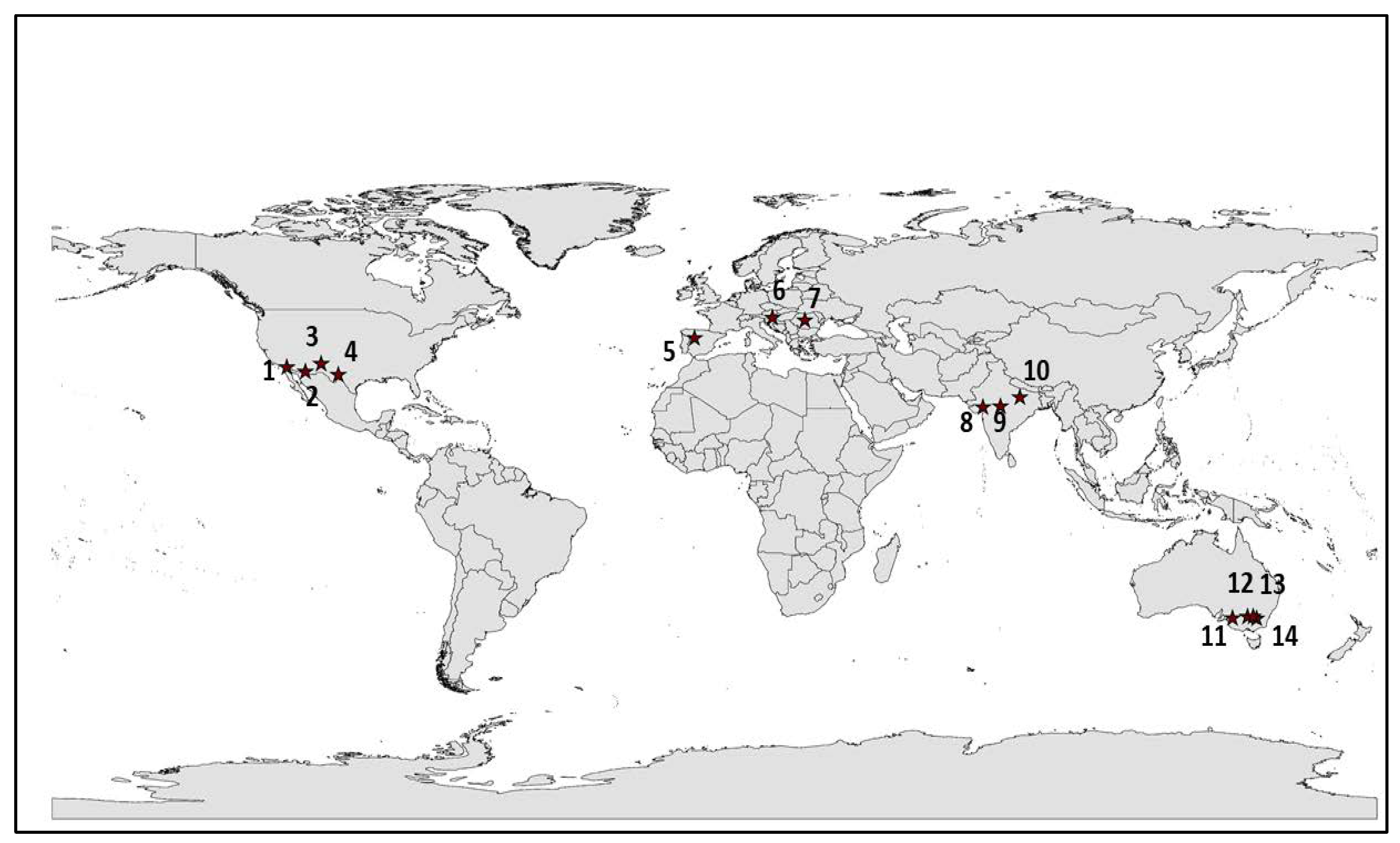

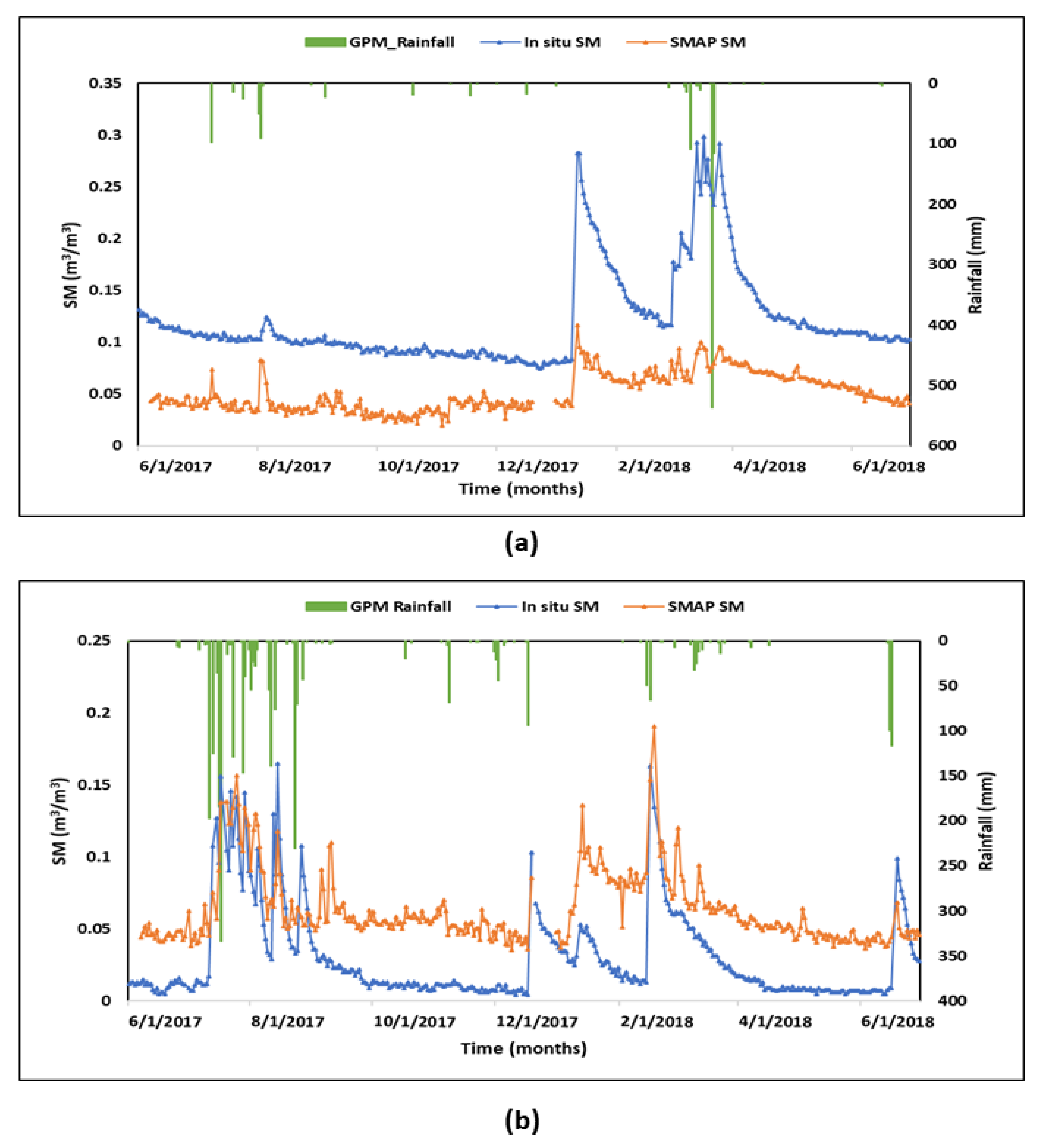
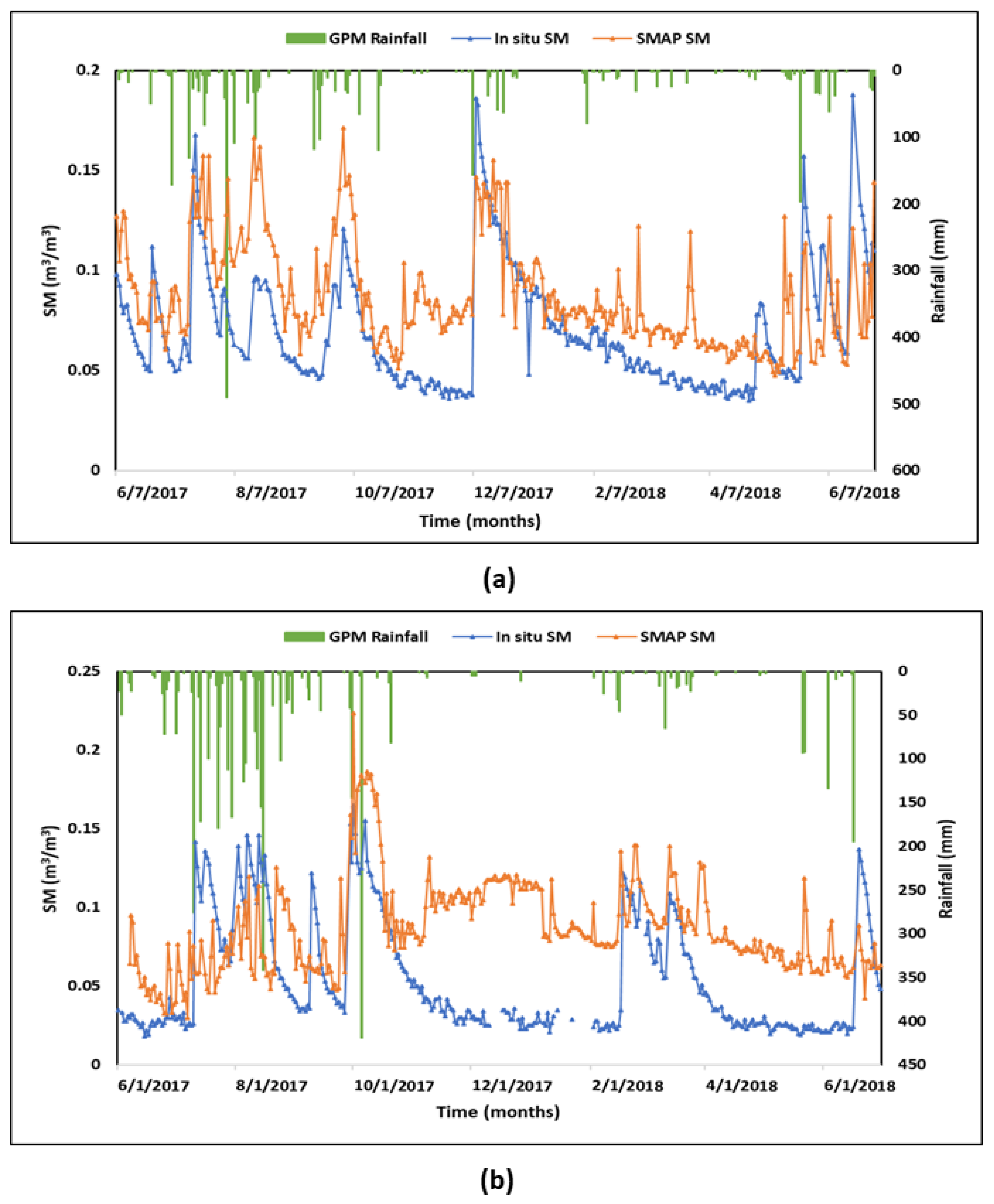
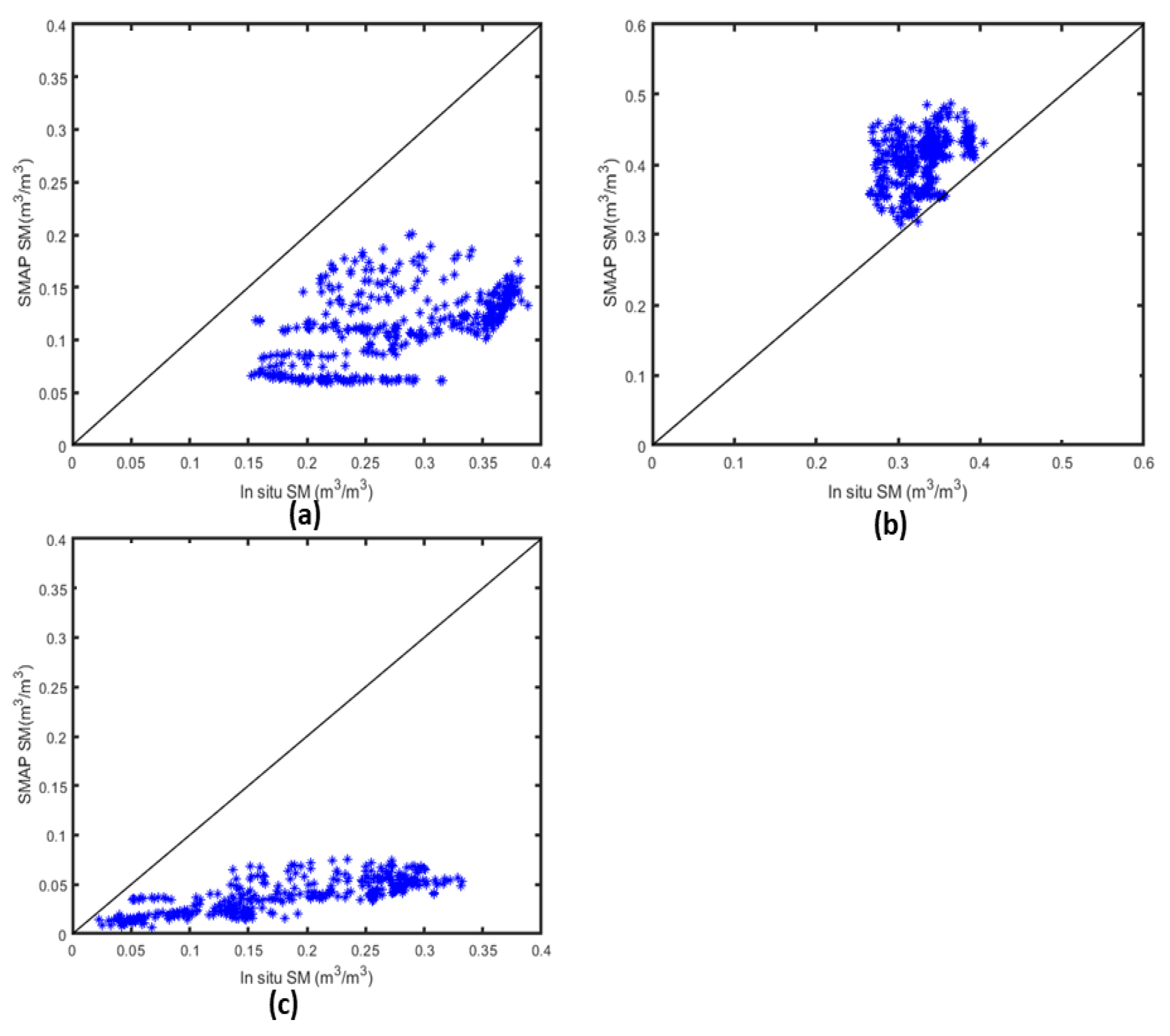
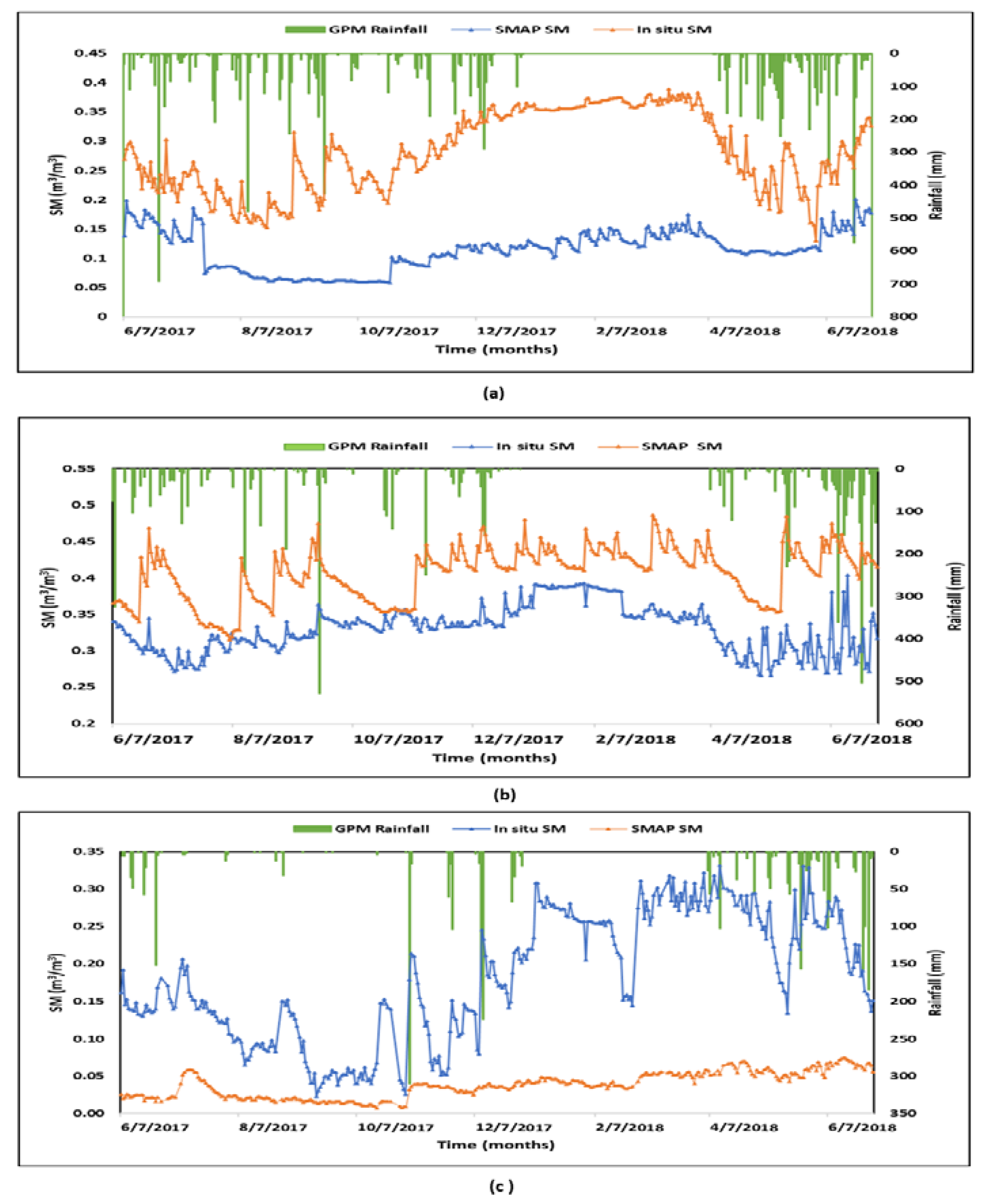

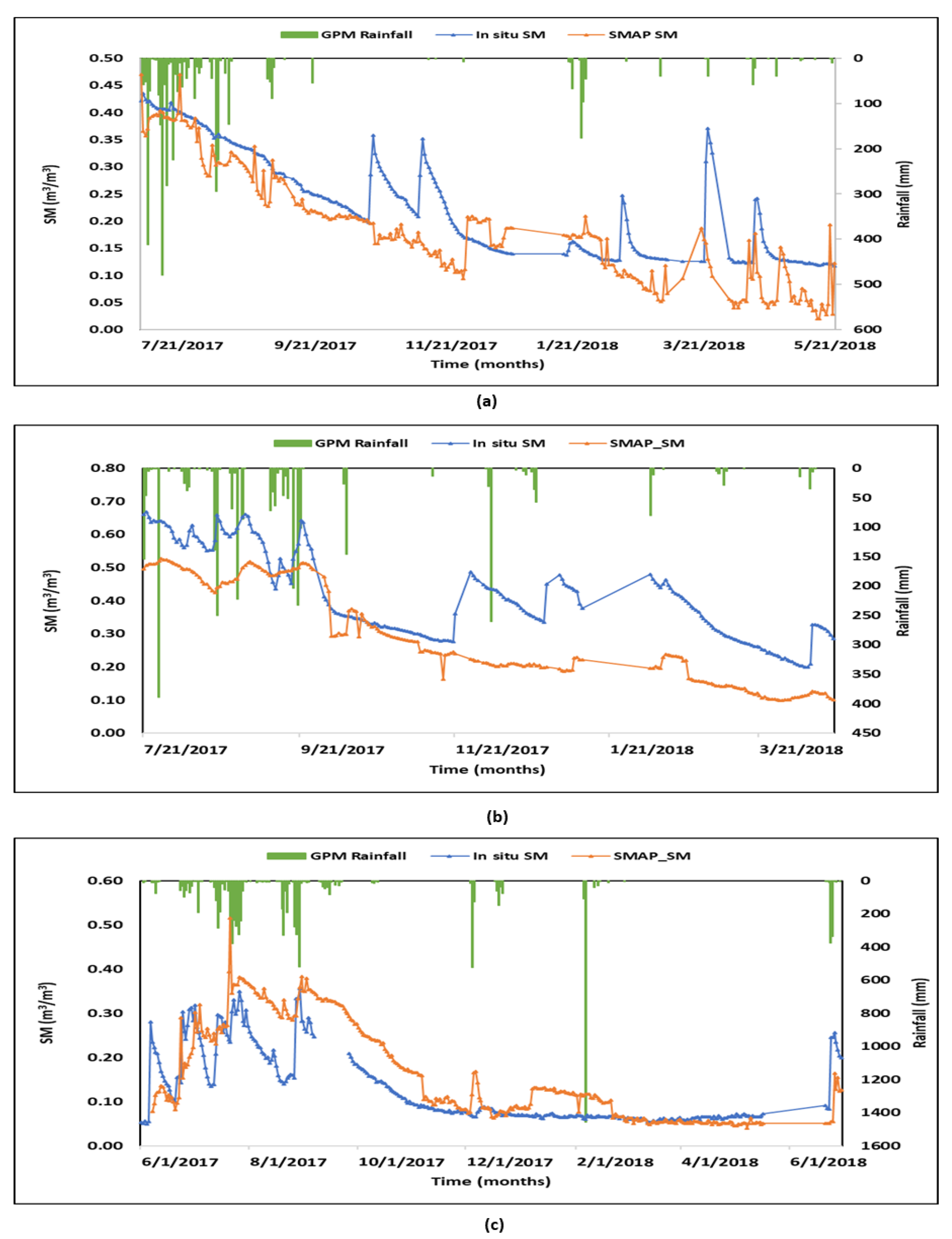
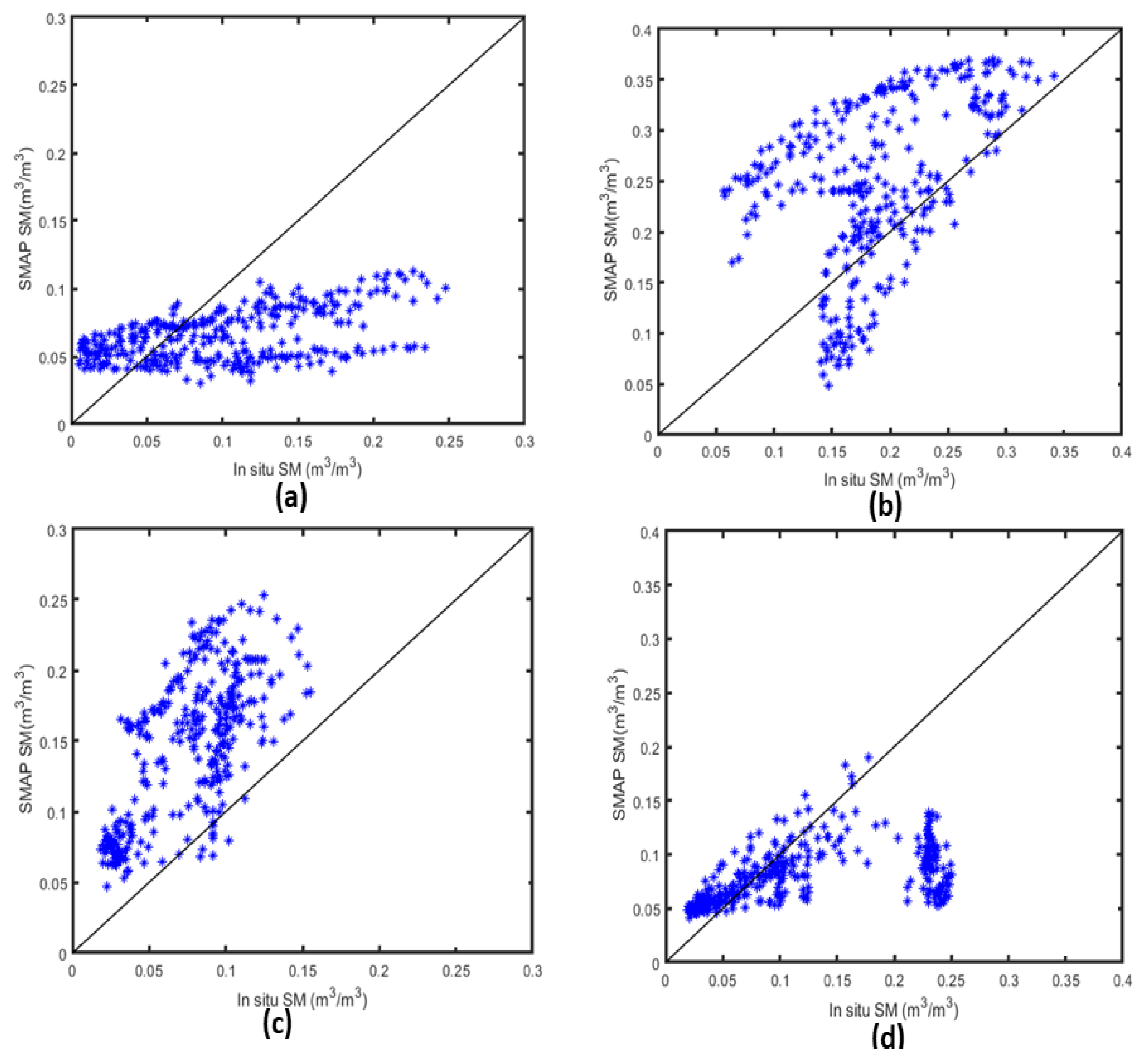
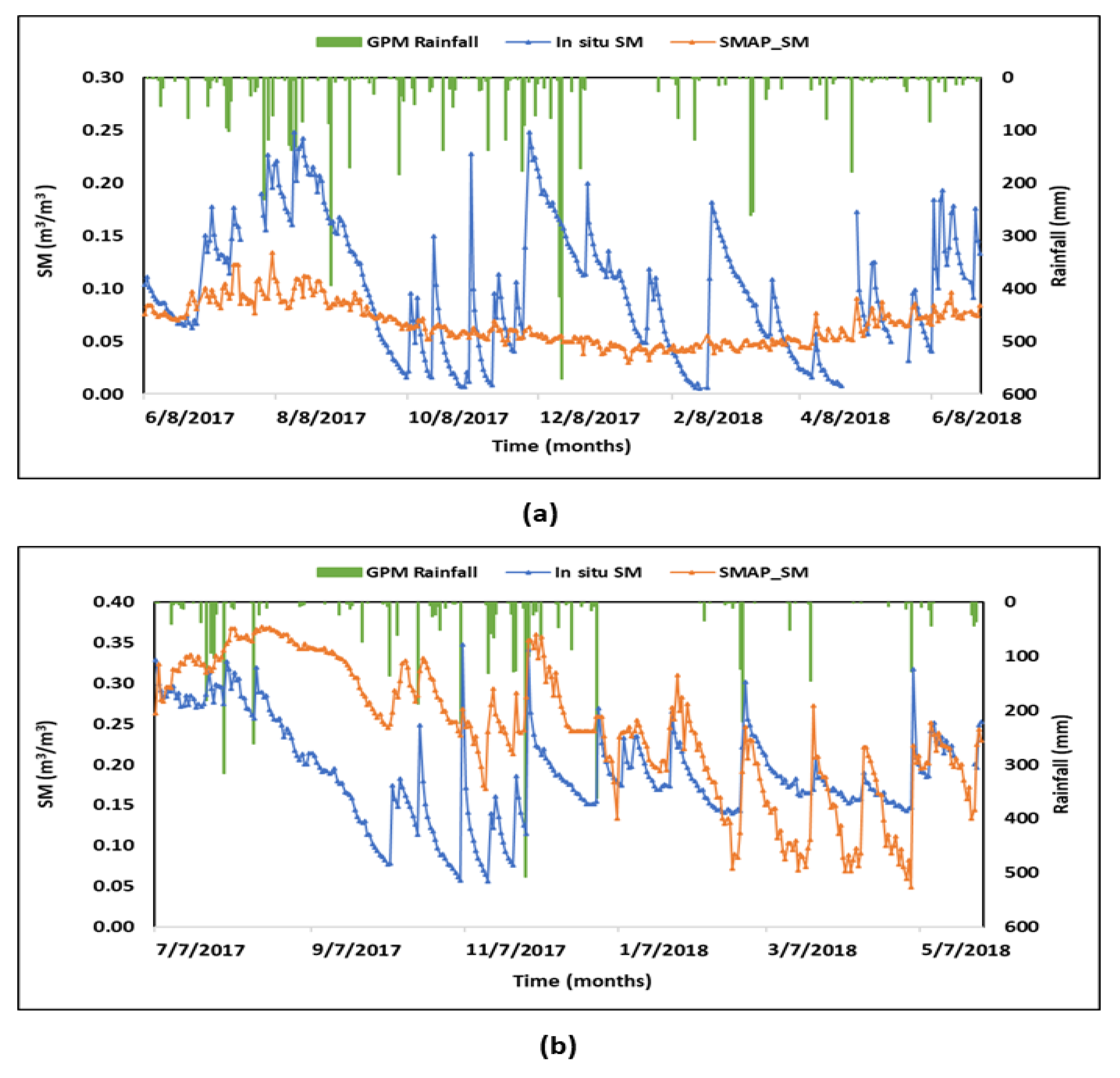
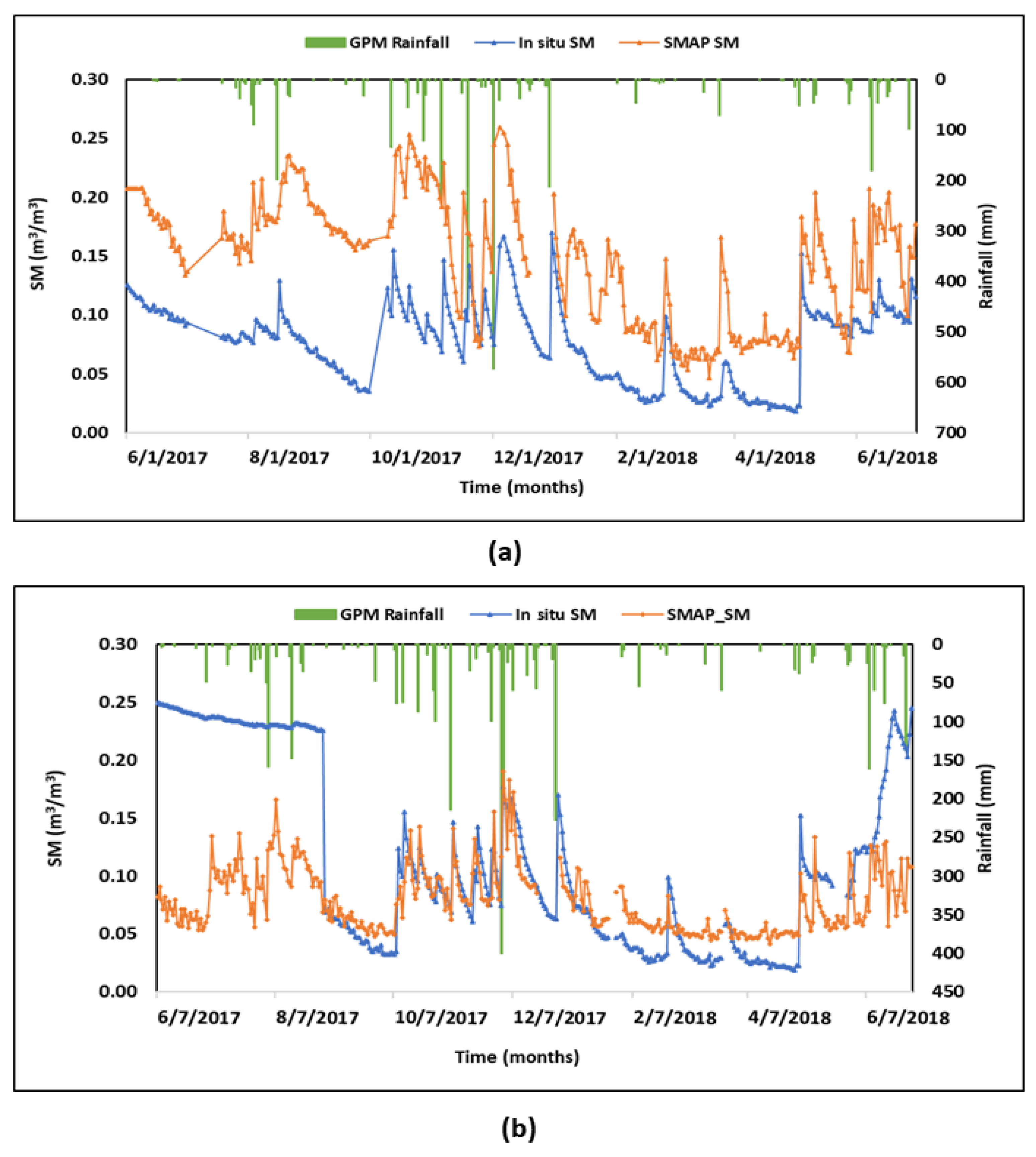
| Location | ISMN Network | Sensor | Soil Depth | Parameters |
|---|---|---|---|---|
| North America (USA) | USCRN | Stevens Water Inc. Stevens Hydra Probe II | 0–0.05 m 0.05–0.1 m 0.1–0.2 m 0.2–0.5 m 0.5–1.0 m | Soil moisture, soil temperature, precipitation, air temperature, surface temperature. |
| Europe (Dumbraveni, Romania) | RSMN | Decagon Device 5TM | 0–0.05 m | Soil moisture, soil temperature, precipitation, air temperature. |
| Europe (Feldbach, Austria) | WEGENERNET | Stevens Water Inc. Stevens Hydra Probe II | 0.0–0.2 m | Soil moisture, soil temperature, precipitation, air temperature. |
| Europe (El Coto, Spain) | REMEDHUS | Stevens Water Inc. Stevens Hydra Probe II | 0–0.05 m | Soil moisture, soil temperature. |
| Asia (India) | Local Network | Stevens Water Inc. Stevens Hydra Probe II | 0–0.05 m | Soil moisture, soil temperature, precipitation, air temperature. |
| Australia (Yanco) | Oz Net | Stevens Water Inc. Stevens Hydra Probe II | 0–0.05 m 0–0.3 m | Soil moisture, soil temperature, precipitation, air temperature. |
| Description | Equations |
|---|---|
| Square of Correlation (R2) | |
| Root Mean Square Error (RMSE) | |
| Degree of Agreement (d) | |
| Percentage bias (PBIAS) |
| Statistical Test | Fallbrook | Tucson | Panther Junction | Socorro |
|---|---|---|---|---|
| Square of correlation (R2) | 0.66 | 0.51 | 0.43 | 0.11 |
| Root mean square error (RMSE) (m3/m3) | 0.08 | 0.04 | 0.03 | 0.05 |
| Degree of agreement (d) | 0.46 | 0.65 | 0.74 | 0.55 |
| PBIAS | −57.9 | 120.60 | 26.10 | 56.80 |
| Statistical Test | Dumbraveni | Feldbach Region | El Coto |
|---|---|---|---|
| Square of correlation (R2) | 0.24 | 0.14 | 0.55 |
| Root mean square error (RMSE) (m3/m3) | 0.18 | 0.09 | 0.16 |
| Degree of agreement (d) | 0.41 | 0.41 | 0.48 |
| PBIAS | −59.30 | 23.0 | −78.50 |
| Statistical Test | Varanasi | Hoshangabad | Anand |
|---|---|---|---|
| Square of correlation (R2) | 0.72 | 0.71 | 0.67 |
| Root mean square error (RMSE) (m3/m3) | 0.07 | 0.14 | 0.07 |
| Degree of agreement (d) | 0.88 | 0.76 | 0.86 |
| PBIAS | −18.60 | −29.60 | 22.90 |
| Statistical Test | Cox | Samarra | Uri Park | Yanco |
|---|---|---|---|---|
| Square of correlation (R2) | 0.24 | 0.19 | 0.48 | 0.29 |
| Root mean square error (RMSE) (m3/m3) | 0.06 | 0.10 | 0.08 | 0.08 |
| Degree of agreement (d) | 0.53 | 0.59 | 0.49 | 0.57 |
| PBIAS | −34.20 | 28.90 | 93.30 | −31.60 |
© 2020 by the authors. Licensee MDPI, Basel, Switzerland. This article is an open access article distributed under the terms and conditions of the Creative Commons Attribution (CC BY) license (http://creativecommons.org/licenses/by/4.0/).
Share and Cite
Suman, S.; Srivastava, P.K.; Petropoulos, G.P.; Pandey, D.K.; O’Neill, P.E. Appraisal of SMAP Operational Soil Moisture Product from a Global Perspective. Remote Sens. 2020, 12, 1977. https://doi.org/10.3390/rs12121977
Suman S, Srivastava PK, Petropoulos GP, Pandey DK, O’Neill PE. Appraisal of SMAP Operational Soil Moisture Product from a Global Perspective. Remote Sensing. 2020; 12(12):1977. https://doi.org/10.3390/rs12121977
Chicago/Turabian StyleSuman, Swati, Prashant K. Srivastava, George P. Petropoulos, Dharmendra K. Pandey, and Peggy E. O’Neill. 2020. "Appraisal of SMAP Operational Soil Moisture Product from a Global Perspective" Remote Sensing 12, no. 12: 1977. https://doi.org/10.3390/rs12121977
APA StyleSuman, S., Srivastava, P. K., Petropoulos, G. P., Pandey, D. K., & O’Neill, P. E. (2020). Appraisal of SMAP Operational Soil Moisture Product from a Global Perspective. Remote Sensing, 12(12), 1977. https://doi.org/10.3390/rs12121977







